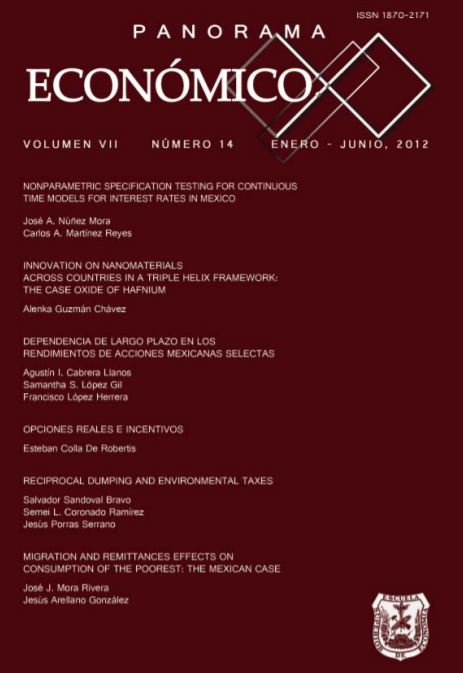Dependencia de largo plazo en los rendimientos de acciones mexicanas selectas.
Contenido principal del artículo
Este artículo muestra los resultados del análisis de los rendimientos de cinco acciones que cotizan en la Bolsa Mexicana de Valores y un tracker que son activos subyacentes de opciones que se comercian en el mercado mexicano de opciones. El objetivo del análisis es encontrar evidencia de la presencia de dependencia de largo plazo o memoria larga en dichos rendimientos y en proxies de las volatilidades de los mismos, mediante diversas pruebas estadísticas que han sido comúnmente utilizadas para este propósito. De acuerdo con los resultados del análisis efectuado, se encuentra evidencia estadísticamente significativa acerca de la presencia de dependencia de largo plazo (memoria larga), tanto en los rendimientos como en los proxies de sus volatilidades, para todos los activos sujetos al análisis.
Anis, A. y E. Lloyd (1976), “The expected values of the adjusted rescaled Hurst range of independent normal summand”, Biometrika, vol. 63, núm. 1, 111-116.
Aydogan, K. y G. G. Booth (1988), “Are there long cycles in common stock returns?”, Southern Economic Journal, vol. 55, núm. 1, 141-149.
Barkoulas, J. T. y C. F. Baum (1996), “Long term dependence in stock returns”, Economics Letters, vol. 53, núm 13, 253-259.
Barkoulas, J. T., C. F. Baum y N. Travlos (2000), “Long memory in the Greek stock market”, Applied Financial Economics, vol. 10, núm 2, 177-184.
Cajueiro, D. O. v B. M. Tabak (2004), “Evidence of long range dependence in Asian equity markets: the role of liquidity and market restrictions”, Physica A, vol. 342, núm. 34, 656-664.
Chang, K. C. y H. S. Kim (2004), “A Study on the nonlinear deterministic characteristics of stock returns , Korean Journal of Finance, vol. 21, núm. 1, 149-181.
Cheung, Y. W. y K. S. Lai (1995), “A search for long memory in international stock market returns”, Journal of International Money and Finance, vol. 14, núm. 14, 597-615.
Conrad, C. (2007), “Non-negativity conditions for the Hyperbolic GARCH model”, KOF Working Papers 162, Swiss Federal Institute of Technology- KOF Swiss Economic Institute, Zurich.
Crato, N. (1994), “Some international evidence regarding the stochastic memory ot stock returns”, Applied Financial Economics, vol. 4, núm. 1, 33-39.
De Bondt, W.F.M. y R. Thaler (1985), “Does the stock market over-react?”, Journal of Finance, vol. 40, núm. 3, 793-805.
Ding, Z., C. W. J. Granger y R. F. Engle (1993), “A long memory property of stock market returns and a new model”, Journal of Empirical Finance, vol. 1, 83-106.
Geweke, J. y S. Porter-Hudak (1983), “The estimation and application of long memory time series models”, Journal of Time Series Analysis, vol. 4, núm. 4, 221-238.
Goetzmann, W. (1993), “Patterns in three centuries of stock market prices”, Journal of Business, vol. 66, núm. 2, 249-269.
Greene ,M. T. y B. D. Fielitz (1977), “Long term dependence in common stock returns”, Journal of Financial Economics, vol. 4, núm. 3, 339-349.
Greene, M. T. y B. D. Fielitz (1979), “The effect of long term dependence on risk-return models of common stocks”, Operations Research, vol. 27 núm. 5, 944-951.
Henry, O. T. (2002), “Long memory in stock returns: some international evidence””, Applied Financial Economics, vol. 12, núm. 1, 725-729
Hiemstra, C. y J. D. Jones (1997), “Another look at long memory in common stock returns”, Journal of Empirical Finance, vol. 4, núm. 4, 373-401.
Hurst, H. E. (1951), “Long-term storage capacity of reservoirs”, Transactions of the American Society of Civil Engineers, vol. 116, 770-799.
Hurvich, C. M., R. Deo y J. Brodsky (1998), “The mean squared error of Geweke and Porter-Hudak’s estimator of the memory parameter in a long-memory time series” , Journal of Time Series Analysis, vol. 19, núm. 1, 19-46.
Islas, Camargo A. y F. Venegas-Martinez (2003), “Pricing derivatives securities with prior information on long-memory volatility”, Economía Mexicana, vol. 12, núm. 1, 103-134.
Kasman, A. y E. Torun (2007), “Long memory in the Turkish stock market return and volatility”, Central Bank Review, vol. 2, núm. 2, 13-27.
Kim, C.S. y P. C. B. Phillips (2000), “Modified log periodogram regression”, Working Paper, Yale Uriversity.
Klemes, V., R. Srikantan y T. A. McMahon (1981), “Long-memory flow models in reservoir analysis: what is the practical value?”, Water Resources Research, vol. 17, núm. 3, 737-751.
Lo, A. W. (1991), “Long-term memory in stock market prices”, Econometrica, vol. 59, núm. 5, 1279-1313.
Lobato, I. y N. Savin, (1997), “Real and spurious long memory properties of stock market data”, Journal of Business and Economic Statistics, vol. 16, núm. 3, 261-283.
López, Herrera F., F. Venegas Martínez y A. Sánchez Dasa (2009), “Memoria larga de la volatilidad de los rendimientos del mercado mexicano de capitales”, Análisis Económico, vol. 24, núm. 56, 129-146.
López, Herrera F., J. I. Villagómez Bahena y F. Venegas Martínez (2009), “Dependencia de largo plazo en rendimientos y volatilidades de acciones mexicanas”, Tiempo Económico, vol. 4, núm. 13, 5-18
López, Herrera F., J. I. Villagómez Bahena y F. Venegas Martínez (2011). “Evidencias de memoria larga en el Indice de Precios y Cotizaciones de la Bolsa Mexicana de Valores”, en M. R. Martínez Preece, C. Zubieta Badillo y F. López Herrera (Coord.), Administración de riesgos Volumen I1, UAM-A, México, 257-280.
Lux,T. (1996), “Long-term stochastic dependence in financial prices: evidence from the German Stock Market” , Applied Economics Letters, vol. 3, núm. 11, 701-706.
Madhusoodanan, T. P. (1998), “Long-term dependence in the Indian stock market”, Journal of Financial Studies, vol. 5, núm. 3, 33-53.
Mandelbrot, B. B. (1971), “When can price be arbitraged efficiently? A limit to the validity of the random walk and martingale Models”, Review of Economics and Statistics, vol. 53, núm. 3, 225-236.
Mandelbrot, B. B. (1972), “Statistical methodology for nonperiodic cycles from covariance to R/S analysis”, Annals of Economic and Social Measurement, vol. 1, núm. 3, 259-290.
Mandelbrot, B. B. (1982), The fractal geometry of nature, W. H. Freeman, San Francisco.
Mandelbrot, B.B., y J. R. Wallis (1969), “Computer Experiments with Fractional Gaussian Noises’, Water Resources Research, vol. 5, núm. 1, 260-267.
McKenzie, M. D. (2001), “’Non-periodic Australian stock market cycles: evidence.From rescaled range analysis”, Economic Record, vol. 77, núm. 239, 393-406.
Mesa, O.J. y G. Poveda (1993), “The Hurst effect: the scale of fluctuation approach”, Water Resources Research, vol. 29, núm. 12, 3995-4002.
Mills, T. (1993), “Is there long-term memory in UK stock returns?”, Applied Financial Economics, vol. 3, núm. 4, 303-306.
Papaioannou, G. J. (1982), “Thinness and short-run price dependence in the Athens stock exchange”, Greek Economic Review, vol. 4, 315-333.
Papaioannou, G. J. (1984), “Informational efficiency tests in the Athens stock market”, en G. A. Hawawini y P. A. Michel (eds), European EquityMarkets: Risk, Return, and Efficiency, Garland Publishing, New York, pp. 367-381.
Peters, E. E. (1992), “R/S analysis using logarithmic returns”, Financial Analvsis Iournal, vol. 48, núm. 6, Nov-Dic, 81-82.
Peters ,E. E. (1994), Fractal Market Analysis, John Wiley & Sons, Inc. New York Quan, Lu Shu, T. Ito y K. Voges (2008), “An analysis of long memory in the SSE’s Component Index”, Journal of Economics, Banking and Finance, vol. 2, núm. 1, disponible en www.scientificjournals.org/journals2008/ articles/1331.pdf.
Robinson, P. M. (1995), “Gaussian semiparametric estimation of long-range dependence”, Annals of Statistics, vol. 23, núm. 5, 1630-1661.
Sierra, Juárez G. (2010), “Modelación de la volatilidad del IPC y del tipo de cambio con brownianos fraccionales”, en Ortiz, Francisco (coord). Avances recientes en valuación de activos y administración de riesgos, vol. 1, Universidad Panamericana, México, 15-35.
Sowell, F. (1992), “Maximum likelihood estimation of stationary univariate fractionally integrated time series models”, Journal of Econometrics, vol. 53 núms. 1-3, 165-188.
Teverovsky, V., M. S. Tagqu y W. Willinger (1999), “A critical look at Lo’s modified R/S statistic”, Journal of Statistical Planning and Inference, vol. 80, núm. 1, 211-227.
Tolvi, J. (2003), “Long memory in a small stock market”, Economics Bulletin, vol. 7, núm. 3, 1-13.
Venegas-Martínez, F. y A. Islas (2005), “Volatilidad de los mercados bursátiles de América Latina: efectos de largo plazo”, Comercio Exterior, vol. 55, núm. 11, 936-947.
Villagómez, Bahena J. I. (2010), “Memoria a largo plazo en los rendimientos y volatilidades de acciones que cotizan en la Bolsa Mexicana de Valores”, en M. R. Martínez Preece y F. López Herrera (Coord.), Administración de riesgos Volumen I, UAM-A, México, 169-188.
Wen, Cheong C. (2008), “Volatility in Malaysian stock market: an empirical study using fractionally integrated approach”, American Journal of Applied Sciences, vol. 5, núm. 6, 683-688.
Yoon, S. M. y S. H. Kang (2008), “Non-periodic cycles and long memory property in the Korean stock market”, The Journal of the Korean Economy, vol. 9, núm. 3, 403-424.
Detalles del artículo

Esta obra está bajo una licencia internacional Creative Commons Atribución-NoComercial-SinDerivadas 4.0.







